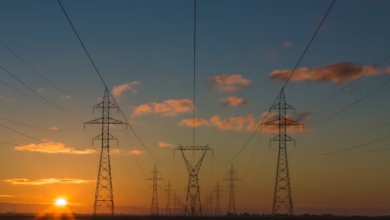Harnessing Carbon Capture and Storage: Innovative Technologies for a Sustainable Energy Transition

As the world grapples with the urgent need to address climate change, Carbon Capture and Storage (CCS) has emerged as a pivotal technology in the energy transition narrative. With the growing reliance on fossil fuels to meet global energy demands, innovative solutions like CCS present a pathway to significantly reduce carbon emissions while supporting energy security. This article explores the multifaceted world of carbon capture technologies that are driving the energy transition and enhancing energy efficiency. We will delve into how CCS plays a crucial role in minimizing fossil fuel dependency and its potential to integrate with renewable energy sources, such as solar power, wind energy, and hydropower, to create a sustainable energy landscape. Additionally, we will examine the future of CCS innovations, particularly how smart grids and energy storage systems can synergize with various energy markets to foster a greener economy. As we navigate these global energy trends, understanding CCS’s role in shaping energy policy and supporting energy exports will be vital for achieving climate change goals and ensuring the viability of our energy systems. Join us as we explore the transformative potential of carbon capture technologies and their significance in the broader context of energy investments and energy R&D.
- 1. Understanding Carbon Capture and Storage: Technologies Driving the Energy Transition
- 2. The Role of Carbon Capture in Achieving Energy Efficiency and Reducing Fossil Fuel Dependency
- 3. Future Innovations in CCS: Integrating Renewable Energy and Smart Grids for Climate Change Solutions
1. Understanding Carbon Capture and Storage: Technologies Driving the Energy Transition
Carbon Capture and Storage (CCS) is emerging as a critical technology in the quest to mitigate climate change and transition towards a more sustainable energy future. As global energy trends shift towards renewable energy sources, the need for effective solutions that can reduce carbon emissions from fossil fuels becomes increasingly urgent. CCS technologies play a pivotal role in this energy transition by capturing carbon dioxide (CO2) emissions produced from industrial processes and energy generation, preventing them from entering the atmosphere.
Understanding the various CCS technologies is essential for grasping their potential impact on energy markets and energy policy. These technologies can be categorized into three main approaches: pre-combustion capture, post-combustion capture, and oxy-fuel combustion. Pre-combustion capture involves removing CO2 from fossil fuels before they are combusted, often utilized in hydrogen energy production. Post-combustion capture, on the other hand, captures CO2 from flue gases after fossil fuels have been burned, making it applicable to existing power plants using thermal energy. Oxy-fuel combustion utilizes pure oxygen instead of air, resulting in a more concentrated stream of CO2 for easier capture.
CCS not only enhances energy efficiency but also complements the integration of green energy sources such as solar power and wind energy. By providing a means to manage carbon emissions from fossil fuels, it ensures energy security while allowing for the gradual phasing out of high-emission resources. This is particularly relevant as countries around the world aim to balance energy imports and exports while meeting climate goals.
Furthermore, the development and deployment of CCS technologies are supported by energy R&D initiatives and significant energy investments. These innovations are crucial for advancing smart grids and distributed energy systems, which are necessary for optimizing energy transportation and storage. As CCS becomes more prevalent, it will likely enhance the viability of offshore energy projects and bioenergy solutions, creating a more diversified energy landscape.
In summary, understanding carbon capture and storage technologies is vital for navigating the complexities of the energy transition. As nations strive to combat climate change while maintaining economic growth, CCS presents an opportunity to harness fossil fuels responsibly, ensuring that energy markets can adapt to the demands of a low-carbon future.
2. The Role of Carbon Capture in Achieving Energy Efficiency and Reducing Fossil Fuel Dependency
Carbon capture and storage (CCS) plays a crucial role in enhancing energy efficiency and reducing dependency on fossil fuels as the world strives to combat climate change. By capturing carbon dioxide emissions produced from industrial processes and energy generation, CCS technologies facilitate a transition towards a more sustainable energy landscape. As global energy trends shift towards renewable energy sources, the integration of CCS is essential for maintaining energy security while reducing greenhouse gas emissions.
The implementation of carbon capture technologies allows existing fossil fuel power plants to operate more efficiently. By capturing up to 90% of CO2 emissions, CCS not only lowers the carbon footprint of thermal energy generation but also enables these plants to continue contributing to energy markets during the energy transition. This approach is particularly important in regions where renewable energy sources, such as solar power, wind energy, and hydropower, may not yet meet demand.
Furthermore, CCS can complement other low-carbon technologies, such as nuclear energy and hydrogen energy, enhancing overall energy efficiency. As the reliance on fossil fuels diminishes, energy investments in CCS can support the gradual phasing out of these traditional energy sources while ensuring a stable supply of energy to meet the needs of electric vehicles and other energy-intensive sectors.
The role of carbon capture also extends to energy storage solutions, which are vital for managing the intermittent nature of renewable energy. By integrating CCS with smart grids and distributed energy systems, operators can optimize energy transportation and storage, reducing waste and improving overall system efficiency. This synergy can lead to significant advancements in energy policy and economics, promoting a more resilient and sustainable energy infrastructure.
In conclusion, carbon capture is a pivotal technology in the pursuit of energy efficiency and the reduction of fossil fuel dependency. By facilitating the transition to greener energy solutions, CCS not only addresses climate change challenges but also positions economies to thrive in a future dominated by renewable energy, energy innovations, and sustainable practices. As nations navigate their energy exports and imports, the integration of carbon capture will be essential for achieving long-term energy goals and securing a cleaner, more sustainable energy future.
3. Future Innovations in CCS: Integrating Renewable Energy and Smart Grids for Climate Change Solutions
As the world strives to combat climate change, the future of Carbon Capture and Storage (CCS) technology is increasingly intertwined with the integration of renewable energy and smart grids. This synergy has the potential to revolutionize how we approach energy transition and reduce carbon emissions from fossil fuels while enhancing energy efficiency and security.
Innovations in CCS are evolving alongside advancements in renewable energy sources, such as solar power, wind energy, and bioenergy. By leveraging these green energy technologies, CCS can significantly improve its carbon capture capabilities. For instance, using surplus renewable energy to power carbon capture processes can minimize the reliance on thermal energy and fossil fuels, leading to a more sustainable energy ecosystem. Furthermore, integrating CCS with energy storage solutions can help manage energy supply and demand, allowing for more effective utilization of captured carbon in various industrial applications.
Smart grids play a crucial role in this innovative landscape by enabling real-time data analysis and management of energy resources. These advanced energy markets facilitate the efficient distribution of renewable energy, encouraging distributed energy generation and consumption. This not only enhances energy security but also creates a more resilient energy infrastructure that can adapt to fluctuating energy demands and supply from renewable sources.
Moreover, the alignment of CCS with global energy trends, such as the shift towards hydrogen energy and electric vehicles, presents an exciting opportunity for energy innovation. By capturing carbon emissions from hydrogen production, we can create a low-emission fuel source that supports energy transportation and reduces our carbon footprint. Additionally, integrating CCS technologies into energy policy frameworks will attract essential energy investments, aiding in the development of offshore energy projects and other renewable initiatives.
In summary, the future of CCS lies in its integration with renewable energy and smart grid technologies. This collaborative approach not only enhances carbon capture efficiency but also fosters a robust energy transition that prioritizes energy sustainability, security, and innovation. As we continue to navigate the challenges of climate change, embracing these advancements will be key to achieving a net-zero future.
In conclusion, Carbon Capture and Storage (CCS) technologies play a pivotal role in the ongoing energy transition, providing essential solutions to reduce carbon emissions and enhance energy efficiency. As we strive to move away from fossil fuels, CCS not only supports the integration of renewable energy sources like solar power and wind energy into our energy markets but also aids in achieving energy security through innovative approaches in thermal energy and hydrogen energy. The future of CCS is bright, with potential innovations that promise to intertwine renewable energy systems with smart grids, enabling a more resilient and sustainable energy infrastructure.
Investments in CCS will be crucial for countries aiming to meet their energy policy goals and combat climate change effectively. By leveraging advancements in energy R&D, including the use of distributed energy and bioenergy, we can create a comprehensive strategy that addresses both energy imports and exports while fostering economic growth. As global energy trends continue to evolve, the role of CCS in facilitating a cleaner energy landscape cannot be understated. It is imperative that we embrace these technologies as part of a broader commitment to a greener, more sustainable future, paving the way for a robust energy economy that values both innovation and environmental stewardship.
Through strategic energy innovations and collaborative efforts, we can ensure that carbon capture not only mitigates emissions but also enhances the overall resilience of our energy systems. The transition to a low-carbon economy is not just a necessity but an opportunity to reshape our approach to energy and drive forward the solutions needed for a sustainable future.





